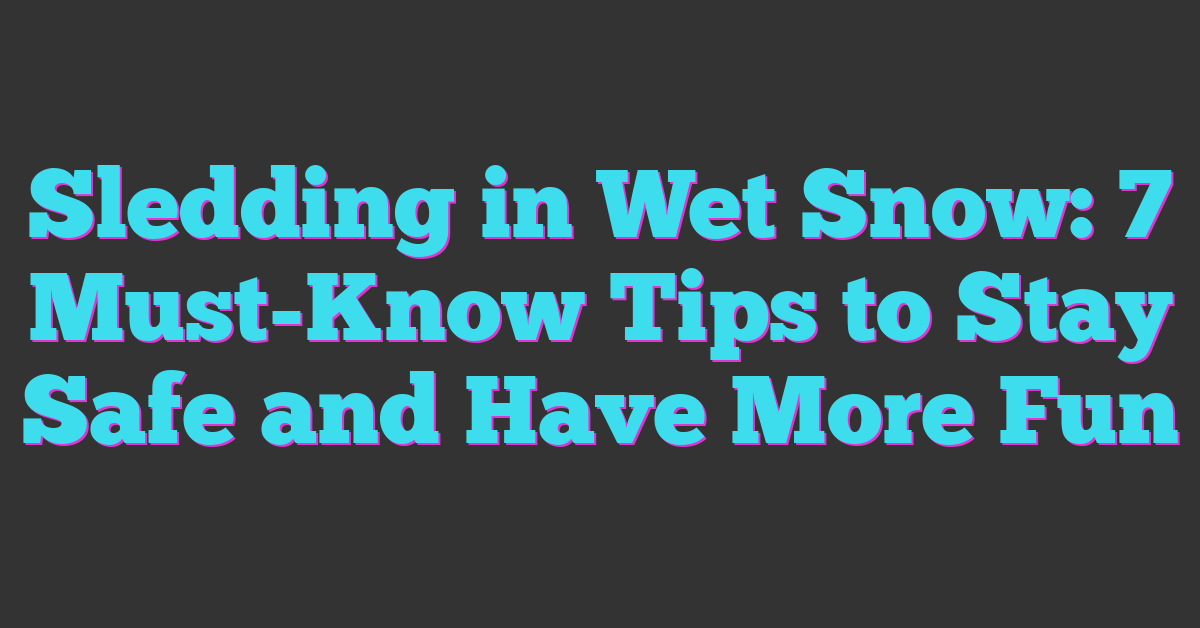Sledding in wet snow can turn a simple winter activity into an exciting adventure or a slippery challenge. If you’ve ever tried to glide down a hill only to find yourself stuck or slowed down, you know wet snow behaves differently from the fluffy powder you might expect. Understanding how it affects your sledding experience can make all the difference.

Whether you’re planning a family outing or just want to enjoy some solo fun, knowing what to expect and how to prepare will help you make the most of your time outside. Wet snow might be heavier and stickier but with the right tips you can still have a blast sliding down those hills safely and smoothly.
Understanding Wet Snow and Its Impact on Sledding
Sledding in wet snow brings a unique set of conditions you’ll want to understand before hitting the slopes. Knowing how wet snow behaves helps you adapt your technique and choose the right gear for a smoother ride.
Characteristics of Wet Snow
Wet snow contains a higher moisture content than dry snow, making it heavier and denser. You can notice its stickiness when packing snowballs or building snow forts; it clumps together easily. This moisture makes the snow slower to melt in shaded areas but also more challenging to push or slide over. When sledding, wet snow creates more friction, reducing speed but increasing control. You’ll find sled tracks are deeper, leaving firmer impressions behind.
How Wet Snow Differs from Dry Snow
Dry snow features low moisture, often powdery and light, allowing sleds to glide quickly with minimal resistance. In contrast, wet snow’s stickiness creates drag that slows sleds considerably. You can expect wetter snow to compact underfoot and under the sled, which changes how you balance and steer. While dry snow may blow around and create powder clouds, wet snow stays put longer but requires more effort to gain momentum. Recognizing these differences lets you choose appropriate sled types and adjust your riding style for the best experience.
Safety Considerations for Sledding in Wet Snow
Sledding in wet snow offers a unique thrill, but it demands extra attention to safety. Understanding how wet snow changes the terrain helps you avoid common risks and enjoy your ride fully.
Common Hazards to Watch Out For
- Slower Speeds with Unpredictable Stops: Wet snow causes more friction, which slows down your sled but can also lead to sudden stops or sticking in unexpected spots.
- Hidden Obstacles under the Snow: Wet snow tends to clump, covering rocks, branches, or ice patches more effectively. You need to scan the hill carefully before sliding.
- Slick and Slushy Surfaces: Near flat areas or hill bottoms, melting wet snow creates slick patches that increase the chance of tipping or losing control.
- Heavy Snowfall and Tree Branches: Wet snow accumulates fast on tree limbs. You should avoid sledding near overhanging branches that risk breakage.
- Cold and Wet Conditions: Saturated gear can sap your warmth quickly. You must wear waterproof clothing to prevent hypothermia.
Tips to Stay Safe While Sledding
- Choose Your Sled Carefully: Use sturdy sleds with smooth bottoms to handle wet snow’s resistance effectively without sticking or flipping.
- Protective Gear Is a Must: Always wear a helmet and consider gloves with good grip. Wet conditions make falls more likely and protect your hands from cold and wet impacts.
- Dress in Layers with Waterproof Outerwear: Because wet snow melts on contact, you need insulated, waterproof jackets and pants to stay dry and warm.
- Scout and Clear Your Path: Walk your sledding hill before use to identify and remove debris or ice patches.
- Keep a Safe Distance: Wet snow can cause a sudden stop, so space out to prevent collisions with others.
- Have Supervision and Emergency Plan: If sledding with kids or friends, always keep an eye on each other and carry a phone or first aid kit just in case.
These safety steps reduce hazards and make sledding in wet snow a rewarding challenge for any snow sports enthusiast.
Best Techniques for Sledding in Wet Snow
Mastering sledding in wet snow takes some skill and the right equipment. Applying these techniques helps you enjoy control and fun despite the denser, stickier snow.
Choosing the Right Sled
Pick a sled with a smooth, durable base designed to glide over wet snow. Sleds made from plastic or fiberglass work best because they resist water absorption and reduce friction. Avoid wooden sleds, as they absorb moisture and slow you down. Consider sleds with runners or narrow bottoms—they cut through the thick snow better and improve steering. Choose a sled size that suits your weight and the hill’s steepness to maintain balance and maximize speed.
Adjusting Your Sledding Approach
Lean back slightly to distribute your weight evenly, preventing the sled’s front from digging into the snow. Use gentle, controlled pushes to start instead of powerful shoves; wet snow adds resistance, so smooth momentum preserves speed. Steer with subtle shifts in body weight rather than sharp turns to avoid sudden stops or tipping. Keep your legs slightly raised to reduce drag from snow buildup. Finally, focus on picking slopes with a gradual incline—steeper hills challenge your control more when wet snow slows you down.
Ideal Locations for Sledding in Wet Snow
Finding the right spot transforms your sledding adventure in wet snow from tricky to thrilling. Picking terrain that matches wet snow’s unique characteristics keeps your ride smooth and safe.
Types of Terrain to Seek
Gentle hills with a consistent, moderate incline offer the best sledding experience in wet snow. Flat sections or long slopes allow you to maintain steady momentum without sudden stops caused by wet snow’s extra friction. Open fields covered with a thick, smooth snow layer minimize hidden obstacles and reduce the chance of getting stuck. Areas with sparse tree coverage provide shade that helps keep the snow from melting too quickly, preserving good sledding conditions longer. Look for slopes with natural runoff paths to avoid icy patches that wet snow can sometimes conceal.
Areas to Avoid
Steep hills increase the risk of losing control since wet snow slows you down but can cause sudden grips or stops. Dense forests or wooded areas often hide branches and stumps beneath wet snow, creating hazards that can damage your sled or lead to falls. Urban parks or places with high foot traffic may pack the snow too hard, combining ice and wetness for unpredictable sliding conditions. Avoid slopes with mixed surfaces, like patches of ice or exposed grass, which worsen wet snow’s inconsistent behavior. Wet snow over uneven terrain increases the chance of tripping or sled damage, so steer clear of rocky or bumpy hills.
Preparing for a Wet Snow Sledding Trip
Getting ready for sledding in wet snow takes a bit more planning than in dry conditions. You want to stay warm, comfortable, and safe while making the most of that heavy, sticky snow.
Clothing and Gear Recommendations
Start with waterproof outer layers. You’ll want a jacket and pants with sealed seams to keep moisture out since wet snow soaks quickly. Insulated gloves with a waterproof shell protect your hands from cold and dampness. Choose moisture-wicking base layers to keep sweat away from your skin, preventing chills. Don’t forget a helmet designed for winter sports; wet snow can slow you down, but unexpected stops still happen. Sturdy winter boots with good traction help you walk on snowy, slippery surfaces safely.
Essential Accessories for Comfort and Safety
Bring goggles with an anti-fog coating to keep your vision clear through wet snowfall and occasional splashes. Carry a small backpack with snacks and water since wet snow slows sledding runs, making breaks more frequent. Hand warmers tucked inside your gloves and boots add extra warmth during long sessions. A compact repair kit for your sled proves handy; wet snow can hide rough spots that might cause dings or scratches. Finally, pack a phone in a waterproof case and share your location if you sled in remote areas—safety matters when the snow puts extra challenges in play.
Conclusion
Sledding in wet snow offers a unique blend of excitement and challenge that can make your winter outings truly memorable. With the right gear, techniques, and mindset, you’ll find ways to enjoy the slower pace and increased control that wet snow brings.
By paying attention to safety and picking the perfect spot, you can turn what might seem tricky into a rewarding adventure. So get out there, embrace the conditions, and have fun making the most of your sledding experience in wet snow!










